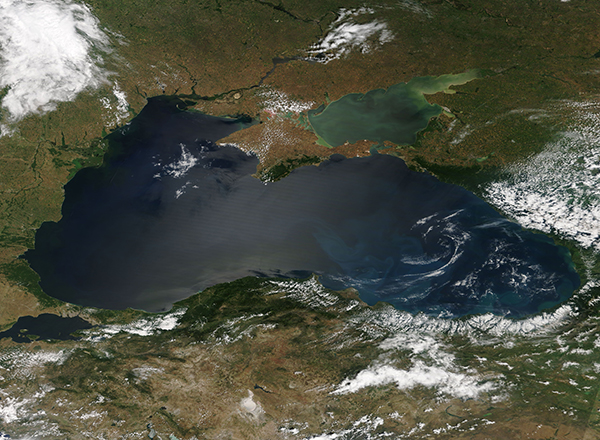Images
June 14, 2018 - Black Sea
Tweet
Swirls of color brightened the deep blue waters of the Black Sea in early June 2018. The Moderate Resolution Imaging Spectroradiometer (MODIS) aboard NASA’s Terra satellite acquired this true-color image on June 11.
Uncertainty spins around how the Black Sea earned its name. Some speculate that it stemmed from black sludge that covered objects in the depths of the sea. Others suggest that the name was coined by sailors who observed that the water appeared black during winter storms. When viewed from space, however, the waters are anything but drab.
The curling arcs of blue and turquoise appear to be blooms of phytoplankton – microscopic plant-like organisms that live in the water year-round in small numbers. When temperature, daylight, and nutrients combine in the right amount, phytoplankton can reproduce rapidly to produce huge blooms that can be seen from space. More than 150 different types of phytoplankton have been observed in the Black Sea, supporting a rich bounty of fish and other marine life.
Image Facts
Satellite:
Terra
Date Acquired: 6/11/2018
Resolutions:
1km (1.9 MB), 500m (5.1 MB), 250m (4.4 MB)
Bands Used: 1,4,3
Image Credit:
Jeff Schmaltz, MODIS Land Rapid Response Team, NASA GSFC
Tweet
Swirls of color brightened the deep blue waters of the Black Sea in early June 2018. The Moderate Resolution Imaging Spectroradiometer (MODIS) aboard NASA’s Terra satellite acquired this true-color image on June 11.
Uncertainty spins around how the Black Sea earned its name. Some speculate that it stemmed from black sludge that covered objects in the depths of the sea. Others suggest that the name was coined by sailors who observed that the water appeared black during winter storms. When viewed from space, however, the waters are anything but drab.
The curling arcs of blue and turquoise appear to be blooms of phytoplankton – microscopic plant-like organisms that live in the water year-round in small numbers. When temperature, daylight, and nutrients combine in the right amount, phytoplankton can reproduce rapidly to produce huge blooms that can be seen from space. More than 150 different types of phytoplankton have been observed in the Black Sea, supporting a rich bounty of fish and other marine life.
Image Facts
Satellite:
Terra
Date Acquired: 6/11/2018
Resolutions:
1km (1.9 MB), 500m (5.1 MB), 250m (4.4 MB)
Bands Used: 1,4,3
Image Credit:
Jeff Schmaltz, MODIS Land Rapid Response Team, NASA GSFC




